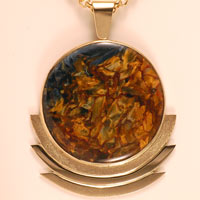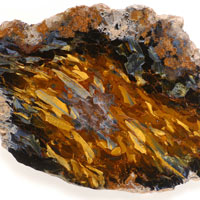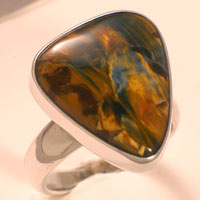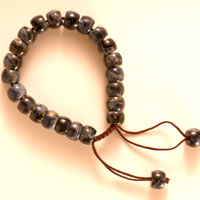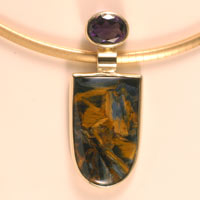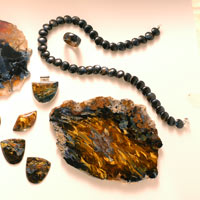Pietersite
Pietersite crystallizes in the form of masses, the structure a result of inclusions in jasper where the inclusions are pseudomorphs after asbestos.
Pietersite crystallizes in the form of masses, the structure a result of inclusions in jasper where the inclusions are pseudomorphs after asbestos.
The color is blue/black and the mineral exhibits a chatoyant quality. It was discovered by Sid Pieters, Windhoek , Namibia , and is truly lovely.
This mineral can be used to stimulate the pineal gland and to assist one during meditative states to experience visions and per-cognitive thoughts. It aligns the energy centers of the body wile providing grounding, not to the Earth, but to the etheric body; this rarity in grounding ability has facilitated travel throughout the spheres of existence, culminating in access to the akashic records.
Pietersite has been said to contain the keys to the kingdom of heaven dispelling illusion and assisting one in the recognition of the beauty of the soul. It exhibits and energy conducive to the actualization of the loving characteristics of the brotherhood of humanity. It brings the potential of the individual to the perfection of the source of all being, stimulating dignified power and loving guidance. It promotes loyalty to the self and to the ultimate experience of life.
It assists one in remaining open to experience, enabling the effect of an illuminated glory when one proceeds to walk the stage of life. It further allows one to see beyond the horizon or mirage, helping to support human courage, tenacity, and dauntless effort to both create and maintain beauty.
This mineral can be used to stimulate the pituitary gland to provide the proper regulation of the other endocrine glands and to produce, in the proper quantity, the hormones concerned with growth , sex, metabolism, blood pressure, and body temperature.
Vibrates to the number 9.
Although crocidelite asbestos is simply a variety of riebeckites occurring in oriented silky fibers as cross-fibre veins, the mane riebeckite is usually applied to the mineral when it is in disoriented rouses. As a rule this material does not enter the re of ornaroentation, but as silica of such material does occur in thus may be suitable for cutting and polishing. That this is so exemplified by an occurrence of silicified reibeckite with limonite which is found in the neighborhood of Outjo in South-West Africa . Attractive variegated golden-brown cabochons of this material have been prepared and marketed by Mr. S. Pieters a mineral dealer of Windhoek , who sells the finished product under the name Pietersite. The density of one such piece was found be about 2.6 and the Mohsi hardness to be similar to that found for tiger-eye. Another alteration product crocidelite reibeckite; consists of a mechanical mixture of silica and hydrated iron and has hardness of 4 on Mohsï scale. This material has been named griqualandite, but it has no place in nur study and as only included in this survey for completeness. A chatoyant fibrous quartz has been obtained on the Cuyuna iron range of Mines in the United States of America . No opportunity to examine this material has presented itself.
Mention must be made of the so-called Hungarian cats-eyes. These yellowish-green chatoyant quartzes containing fibrous amphibloe inclusions are obtained form the database of Holf and other place in the Fichtelgeberge in Ravaria. They do not come from Hungary . Such stones are inferior to the cat-eyes found in India and Ceylon , and probably abey are offen artificial stained different colors.
DISCOVERER OF SEMI-PRECIOUS STONE VISITS FACTORY
Mr. Sid Pieters the man who discovered the semi-precious stone, Pietersite was in Hermanus recently where he paid a visit to Tiger-Eye to see how his discover was being used.
Mr. Pieters discovered this stone in 1962 while prospecting on a farm in Namibia .
He came across a rather heavy small stone covered in white limestone. As he could not see what was in the stone, he took it back to his work shop in Windhoek , where he cut it open to discover the beautiful blue and gold colored patterns of the stone which he later named after himself.
He returned to the farm in Namibia where he began mining the stone, but after a short period of time, due to most of the material begin stolen, he abandoned the mine.
In the meantime however, he registered the find in the mineral records of Britain , and it was published in 1964 as Pietersite.
Pietersite is one of the Riebeckite family of silicified and asbestos stones. The most common is the yellow variety known as Tiger-eye and the blue variety known as Hawkeye well as weathering.
"Of all the gemstones I have seen worldwide , Pietersite is one of the most beautiful", says Mr. Pieters.
Due to these characteristics, Pietersite is one of the foremost stones used in jewellery and ornamental pieces worldwide, and as it is a very hard and tough stone lasts for many years.

